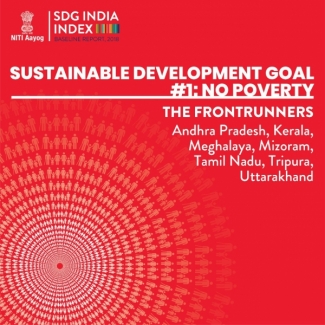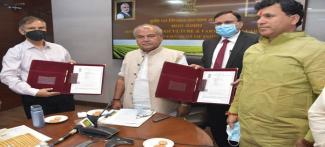
A single measurable Index to map progress of States & UTs towards 2030 SDGs
The NITI Aayog today released the Baseline Report of the Sustainable Development Goals (SDG) India Index, which comprehensively documents the progress made by India’s States and Union Territories towards implementing the 2030 SDG targets.
The SDG India Index, has been developed in collaboration with the Ministry of Statistics & Programme Implementation (MoSPI), Global Green Growth Institute and United Nations in India.
NITI Aayog has the twin mandate to oversee the implementation of SDGs in the country, and also promote Competitive and Cooperative Federalism among States and UTs. The SDG India Index acts as a bridge between these mandates, aligning the SDGs with the Prime Minister’s clarion call of Sabka Saath, Sabka Vikas, which embodies the five Ps of the global SDG movement – people, planet, prosperity, partnership and peace.
The world is now into the third year of the SDG era. The SDGs are ambitious global development goals that address key aspects of universal wellbeing across different socio-economic, cultural, geographical divisions and integrate the economic, social and environmental dimensions of development.
India’s National Development Agenda is mirrored in the SDGs. India’s progress in SDGs is crucial for the world as the country is home to about 17% of the world population.
The SDG India Index tracks progress of all States and UTs on 62 Priority Indicators selected by NITI Aayog, which in turn is guided by MoSPI’s National Indicator Framework comprising 306 indicators and based on multiple-round consultations with Union Ministries/Departments and States/UTs.
The Index spans 13 out of 17 SDGs. Progress on SDGs 12, 13 & 14 could not be measured as relevant State/UT level data were not available and SDG 17 was left out as it focuses on international partnerships.
A composite score was computed between the range of 0-100 for each State and UT based on their aggregate performance across 13 SDGs, which indicates average performance of State/UT towards achieving 13 SDGs & their respective targets.
If a State/UT achieves a score of 100, it signifies that it has achieved the 2030 national targets. The higher the score of a State/UT, the greater the distance to target achieved.
Classification Criteria based on SDG India Index Score is as follows:
-
-
- Aspirant: 0-49
- Performer: 50-64
- Front Runner: 65-99
- Achiever: 100
-
|
OVERALL |
Aspirant |
Assam, Bihar and Uttar Pradesh |
|
Performer |
Andhra Pradesh, Arunachal Pradesh, Chhattisgarh, Goa, Gujarat, Haryana, Jammu & Kashmir, Jharkhand, Karnataka, Madhya Pradesh, Maharashtra, Manipur, |
|
|
Front Runner |
Himachal Pradesh, Kerala, Tamil Nadu, Chandigarh and Puducherry |
|
|
Achiever |
NA |
The SDG India Index is available via an interactive dashboard which has cross-sectoral relevance across policy, civil society, business and academia. The Index is designed to function as a tool for focused policy dialogue, formulation and implementation, moving towards development action pegged to globally recognisable metrics of SDG framework.
The Index also supplements NITI Aayog’s continuous efforts towards encouraging evidence-based policy making by supporting States/UTs to benchmark their progress, identifying priority areas and share best practices.
The SDG India Index will also help highlight crucial gaps related to tracking SDGs and the need for India to develop its statistical systems at National & State/UT levels. This shall lead to the index evolving and becoming more comprehensive over the coming years. The indicators shall be further refined and additional indicators will be added with improvement in data collection, reporting processes & methodology. NITI Aayog is also exploring potential for disaggregating data and developing capacity for real time monitoring and measuring incremental progress.
The full SDG India Index report can be accessed here: http://niti.gov.in/content/sdg-india-index-baseline-report-2018
The interactive dashboard can be found here: http://sdgindiaindex.socialcops.com











